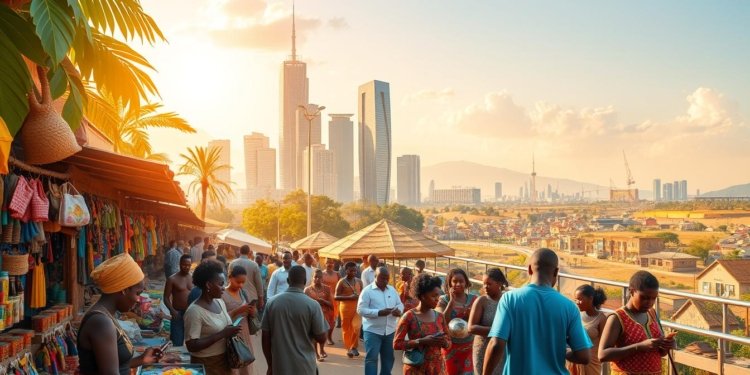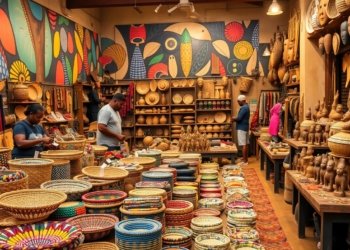Could Africa become the next global leader in digital retail? With a projected market value of $1,017 billion by 2033, the continent is rewriting the rules of online shopping. Its rapid expansion outpaces many developed regions, fueled by mobile adoption and a young, tech-savvy population.
South Africa currently dominates with a $317 billion market size, but Nigeria, Kenya, and Ghana are catching up fast. Over 152 million users are expected by 2029, yet penetration remains at just 13.1%. This gap reveals untapped potential, especially as smartphone ownership and payment solutions improve.
Local platforms like Jumia and Konga prove innovation thrives here. Mobile money services process billions annually, while cross-border trade grows at 13% yearly. The question isn’t if Africa will rise—it’s how quickly.
Key Takeaways
- Africa’s digital retail sector could hit $1 trillion by 2033.
- South Africa leads today, but Nigeria and Kenya show explosive growth.
- Mobile devices drive over 60% of transactions.
- Local platforms outperform global giants in several markets.
- Payment innovations like mobile money unlock new opportunities.
The Current State of E-Commerce in Africa
Mobile-first strategies are propelling Africa’s digital shopping revolution. With a $39.44 billion market in 2025, the continent’s revenue is set to surge to $54.65 billion by 2029. Fashion leads at 32%, followed by electronics (28%), reflecting shifting consumer priorities.
Market Size and Revenue Projections
Annual revenue per user ($368.24) outpaces global averages, growing at 17.1% YoY. Nigeria’s 89% mobile payment adoption fuels this expansion, while Kenya’s M-Pesa ecosystem processes billions. Urban areas drive 27% of transactions, but rural zones lag at 6% due to infrastructure gaps.
User Penetration and Digital Adoption
Only 13.1% of Africans shop online, far below Asia (58%) or Europe (79%). Yet, 73% of transactions occur via smartphones, highlighting mobile’s critical role. COVID-19 accelerated shifts, with 41% of consumers permanently switching to online platforms.
Logistics remain a hurdle—60% cite delivery concerns. However, innovations like motorbike fleets and local pickup points are bridging gaps. As internet access improves, Africa’s untapped potential becomes undeniable.
Key Drivers of E-Commerce Growth in Africa
Africa’s digital marketplace is booming, driven by unique local innovations. Three factors stand out: mobile access, financial inclusion, and a young population eager to adopt new tech.

Rising Smartphone and Internet Penetration
Smartphone adoption jumped from 41% in 2019 to 64% in 2024. Over 800 million internet users now exist, with mobile devices handling 60% of transactions.
MTN’s Ayoba super-app exemplifies this shift. It combines messaging, payments, and shopping, attracting millions of users.
Economic Stability and Digital Literacy
Digital literacy programs boosted adoption by 34% since 2020. Konga’s school tech initiatives train future consumers, while 48% of the population is under 25.
Flutterwave’s $250M funding highlights investor confidence. Such platforms simplify cross-border deals, fostering trust.
Localized Payment Solutions
Mobile money dominates, with 75% of transactions versus 23% for credit cards. Safaricom’s M-Pesa processes $364B yearly, proving its scalability.
JumiaPay and Paystack reduce cart abandonment by 68%. Cash-on-delivery remains popular, preferred by 89% of new users.
These solutions bridge gaps where traditional banks reach only 38% of the population.
Market Segmentation: Business Models and Product Types
Africa’s digital retail landscape is evolving through distinct business models and product categories. From B2C dominance to niche sectors like solar panels, the market reflects diverse consumer needs and innovative solutions.
B2C, B2B, and C2C Trends
B2C models lead with 67% of revenue, driven by platforms like Takealot and Jumia. Alibaba’s B2B expansion struggles to match local agility, while C2C platforms like Jiji thrive with peer-to-peer sales.
eBay’s challenges highlight the importance of localized trust. Jiji’s success stems from adapting to cash-on-delivery preferences, which 89% of new users favor.
Dominance of Clothing and Accessories
Fashion claims 38% of the market, outpacing electronics (12%). Jumia reports 58% of sales from clothing, while Konga focuses on electronics (41%).
Zando’s private labels boost margins by 22%, proving brand loyalty matters. Luxury goods, though niche, grow at 14% annually.
Emerging Sectors: Groceries and Electronics
Groceries surge at 21% CAGR, led by Twiga Foods’ $50M tech-driven supply chain. Pharmaceuticals also rise, with 34% of health purchases now online.
Electronics face hurdles like 22% return rates for furniture. Yet, automotive parts emerge as a $780M sub-sector, showing untapped potential.
Regional Insights: Leading Markets and Opportunities
South Africa, Nigeria, and Egypt demonstrate three distinct paths to digital commerce success. While South Africa dominates current revenue shares, Nigeria’s rapid expansion and Egypt’s tech investments reveal untapped potential. This regional diversity creates a dynamic market landscape across the continent.

South Africa’s Dominance in the Market
Controlling 41% of continental revenue, South Africa sets the standard for mature digital markets. Takealot commands 58% local share, outpacing Amazon’s tentative entry plans. Government-backed initiatives like DE4A strengthen this position through infrastructure investments.
Urban concentration (71% in Morocco vs. 63% in SA) impacts delivery efficiency. Yet, South Africa’s logistics networks outperform neighbors, enabling same-day delivery in major cities. This advantage attracts global companies testing African expansions.
Nigeria and Egypt: Rising Stars
Nigeria’s 18.7% CAGR stems from Jumia’s 12 million active users and mobile payment adoption. Egypt counters with 62% sector growth since 2021, fueled by Fatura’s $3M B2B seed round. Both countries leverage youthful populations to drive innovation.
Kenya’s 43% mobile commerce adoption contrasts with Ghana’s 29%, showing regional disparities. Rwanda’s drone delivery systems leapfrog infrastructure gaps, while Tunisia’s European trade links enable cross-border growth. Ethiopia’s protectionist policies, however, limit foreign platform access.
Algeria’s $4.2B potential remains constrained by payment barriers, unlike Egypt’s thriving fintech scene. The DRC’s 8% internet penetration highlights both challenges and opportunities in Africa’s evolving online retail ecosystem.
Competitive Landscape: Major Players and Strategies
Africa’s digital commerce arena is witnessing fierce competition between global titans and homegrown champions. Local platforms like Jumia and Takealot dominate with tailored services, while Amazon and Alibaba strategize entry through logistics partnerships.
Global Giants vs. Local Innovators
Jumia operates in 11 countries with 8.6 million active customers, leveraging 500+ pickup stations. Amazon plans 7 fulfillment centers but trails local players in speed—Takealot offers same-day delivery in South African cities.
Alibaba’s Lazada struggles against Kenya’s Wasoko, which secured $125M to scale. Shopify’s 89% merchant growth highlights how local agility outperforms global scale. Clickatell’s chat commerce processes $2.1B, proving mobile-first solutions win.
Investment in Logistics and Technology
DHL’s $100M logistics push complements Konga’s 28 warehouses. UPS targets pharma delivery with cold-chain tech, while Copia’s rural agent network bridges last-mile gaps.
Payment innovations like M-Pesa and JumiaPay reduce cart abandonment by 68%. These investments redefine Africa’s market, where companies must blend global tech with local trust.
Conclusion
Africa’s digital retail sector is on track to reshape global commerce. With a projected $1 trillion market value by 2033, mobile-first strategies and localized payments will drive expansion. Over 60% of transactions already happen via smartphones, proving tech adoption is accelerating.
Local platforms like Jumia outperform global giants by tailoring services to regional needs. Groceries and electronics emerge as key growth areas, while logistics improvements remain critical. Investors should watch Kenya’s thriving tech ecosystem for signals of broader trends.
The future hinges on bridging infrastructure gaps and regulatory hurdles. Companies entering this space must prioritize mobile access and trust-building to succeed. Africa’s potential is undeniable—the time to engage is now.
FAQ
How big is the online retail market in Africa?
The market is growing rapidly, with revenue projected to exceed billion by 2025. South Africa, Nigeria, and Egypt lead in sales, driven by smartphone adoption and digital payments.
What products are most popular among African shoppers?
Clothing and accessories dominate, but groceries and electronics are gaining traction. Consumers prefer platforms offering secure transactions and fast delivery.
Which countries have the highest internet penetration for shopping?
South Africa leads with over 60% of users buying online. Nigeria and Kenya follow closely, thanks to affordable mobile data and expanding logistics networks.
How do payment methods impact digital commerce growth?
Localized solutions like M-Pesa and mobile wallets boost trust. Over 70% of transactions occur via phones, making seamless payments critical for market expansion.
Who are the major players in Africa’s digital retail space?
Jumia and Takealot dominate, but global brands like Amazon are entering. Local startups thrive by tailoring services to regional needs, such as cash-on-delivery options.
What challenges hinder faster adoption of online shopping?
Logistics gaps and low trust in digital channels persist. Companies investing in last-mile delivery and buyer protection see higher repeat purchase rates.
Are businesses focusing more on B2B or B2C models?
B2C drives most sales, but B2B platforms are rising, especially in agriculture and wholesale. Both models benefit from improved access to smartphones and banking services.





